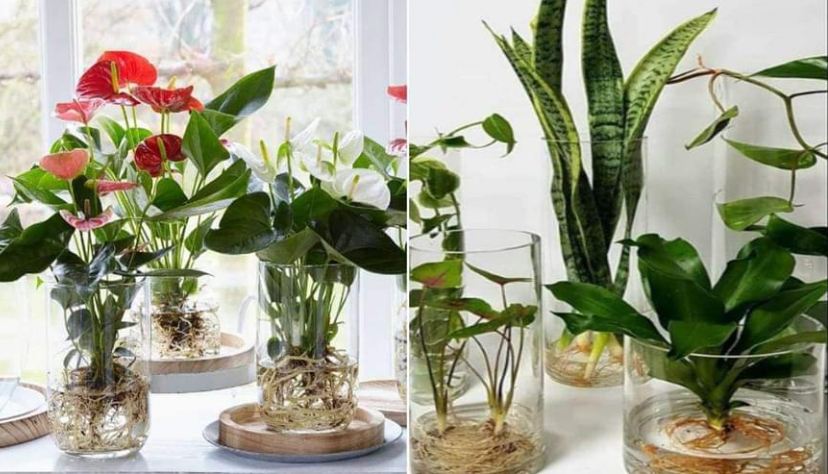1. **Water Lilies (Nymphaea spp.)**
Water lilies are iconic aquatic plants, widely admired for their beauty. Their large, fragrant flowers bloom on the water’s surface, with colors ranging from pure white to soft pink, yellow, and bold red. These plants float on the water, their broad, round leaves, known as pads, provide shade and create a peaceful atmosphere. Water lilies also help maintain water quality by reducing algae growth and preventing the sun’s rays from penetrating too deep into the water. They are a perfect addition to ponds, offering both visual appeal and benefits to aquatic ecosystems.
2. **Lotus (Nelumbo spp.)**
Lotus plants are known for their elegant, large flowers that rise above the water on tall, sturdy stalks, creating a striking contrast to their broad, heart-shaped leaves that float gracefully on the surface. Their flowers bloom in colors like white, pink, and yellow, often associated with tranquility, spirituality, and purity. While they grow best in shallow, warm waters, lotus plants are resilient and can adapt to a variety of aquatic environments. They have long been symbols of beauty and enlightenment in many cultures, making them a spiritual and aesthetic addition to any water garden.
3. **Water Hyacinth (Eichhornia crassipes)**
Water hyacinths are fast-growing, free-floating plants with distinctive, glossy, rounded leaves. These plants are prized for their light lavender-blue flowers that bloom above the water. As one of the most invasive aquatic species in many regions, water hyacinth is highly effective at covering the water’s surface, creating a lush, floating carpet. While they can be aggressive and should be managed in outdoor environments, they also provide valuable benefits, such as improving water quality by filtering toxins and offering shelter for aquatic life.
4. **Anubias (Anubias spp.)**
Anubias is a versatile and hardy plant frequently used in aquariums due to its ability to thrive in a variety of water conditions. With dark green, thick leaves and slow growth, it’s an ideal plant for those seeking low-maintenance aquatic life. Anubias can thrive without soil by being anchored to rocks or driftwood. If conditions are optimal, it will even bloom with small white flowers, adding subtle elegance to your water garden. Their resilience makes them an excellent choice for beginners and aquarium enthusiasts alike.
5. **Water Poppy (Hydrocleys nymphoides)**
The water poppy is a charming aquatic plant with bright yellow, cup-shaped flowers that rise above the water. The flowers have a dark center that contrasts beautifully with their heart-shaped, floating leaves. Water poppies are easy to care for and thrive in shallow water, making them perfect for adding a cheerful touch to ponds or water gardens. They are also known for their rapid growth and ability to quickly cover the surface of a pond, offering a stunning contrast to deeper-water plants like water lilies.
6. **Lucky Bamboo (Dracaena sanderiana)**
Despite its name, lucky bamboo is not a true bamboo but rather a member of the Dracaena family. It’s an incredibly easy-to-grow plant that can thrive in just water, often featured in decorative arrangements. Lucky bamboo has slender, upright stalks that grow vertically, with lance-shaped leaves growing from the tips of the stems. Known for its air-purifying qualities and simple, minimalist aesthetic, lucky bamboo is often used in feng shui to attract positive energy and good fortune, making it an ideal indoor plant that requires little maintenance.
7. **Papyrus (Cyperus papyrus)**
Papyrus is a tall, elegant plant that adds a touch of drama to any water garden. The plant features numerous thin green stems that rise upward, topped with tufts of spiky, grass-like bracts, giving it a distinctive, umbrella-like appearance. It can thrive in shallow water or marshes and does well with its roots submerged. In ancient times, papyrus was used to make paper, but today, it’s valued for its ornamental qualities and its ability to create a sense of verticality and texture in water gardens and ponds. Papyrus also attracts wildlife, making it a beneficial addition to aquatic ecosystems.
—
These plants are all well-suited to growing in water, with some even thriving without soil. Whether you’re looking to add beauty, improve water quality, or support aquatic wildlife, these water-loving plants can bring a unique, natural element to your garden or indoor spaces.
